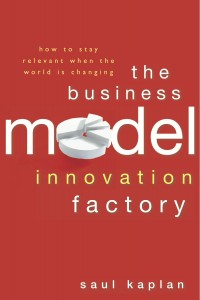
My pal Saul Kaplan is a self-confessed innovation junkie. That’s all he seems to think, talk, and tweet about (with occasional detour for Boston sports teams.) He’s the founder and chief catalyst of the Business Innovation Factory in Providence and the proprietor of the most excellent annual conference of the same name.
Now he’s taken the wisdom he’s acquired over the years and turned it into a book about an urgent, but often overlooked, topic: Business models. In The Business Model Innovation Factory: How to Stay Relevant When the World is Changing (Buy it at Amazon, BN.com, or IndieBound), Kaplan outlines a set of principles that individuals and organizations can enlist to avoid getting steamrollered by competitors who do somewhat similar things but in distinctly different ways.
Because the book is so relevant to the issues many of us confront, I asked Saul to answer a few questions for Pink Blog readers:
You start off your book by saying “The goal for all leaders is to avoid being netflixed.” Could you explain a little bit about what it means to be “netflixed”?
Being netflixed means the way you do business today is disrupted, displaced, or destroyed by a competitor who plays by an entirely new set of rules. Blockbuster was netflixed. It was stuck in a bricks and mortar business model and was obliterated by the upstart Netflix. Today all companies, even Netflix, are vulnerable to being netflixed. Business models don’t last as long as they used to. The imperative for all leaders is to experiment with new business models even the disruptive ones.
In your experience, do companies usually see disruptive innovation and underestimate it, or are companies completely blind to it? How can we become more attuned to changes ahead?
Companies fail at avoiding disruption because they are so busy pedaling the bicycle of their current business model. They leave no time or resources to design, prototype, and test new ones. Every new technology is seen as a way to make the existing business model stronger rather than enabling entirely new ones. It’s not that companies don’t see disruption on the horizon, it’s that they wrongly think they can lean against it or prevent it. Companies need sandboxes to make it safe and more manageable to play with disruptive approaches. If you don’t learn how to disrupt yourself, someone else will.
One of your key points is that business model innovation has to involve the end user or the customer. Has social media made this process easier? How do you screen out the noise?
The only way to go from tweaks to transformation is to change your lens. Instead of viewing opportunities through the lens of your business model, adopt the lens of your customer. Don’t just understand customer experience. Engage them directly in the design of new business models. Social media can unleash entirely new business models, but most companies still treat it as an extension to marketing and communication departments. It’s bigger than that. All business is social. Curation and filtering become important organizational capabilities to create more signal and less noise.
You say at one point that “products and services that meet customer needs but with small initial market potential…are discarded,” leaving a gap for competitors to rush in and fill. Given a choice, would you choose to have lots and lots of customers, or a small group of very loyal customers?
Companies always establish financial hurdles that make it difficult to experiment with new ways to meet unmet customer needs. Once competitors swoop in and get a market foothold, they inevitably come after your core customers. Given a choice, I want engaged customers. I want to deliver experiences that customers are passionate about. I would rather have a solid base of committed customers, motivated to spread the word about their experience, to build from. Far too many companies lack real engagement with their customers, leaving them vulnerable to competitors who are creating more of a movement than a company. Think Apple, Zappos and 37 Signals.
What is one thing the innovative readers of this blog could do today to get their great ideas out of their heads, off their whiteboards, and into real-world testing?
I use the technical term: “We need to try more stuff!” My mantra is, think big, start small and scale fast. Somewhere along the way we’ve become afraid of trying. We don’t like to fail. I don’t know how you learn anything new if you don’t experiment all the time. We should reframe failure as intentional iteration! We have to reinvent ourselves several times over the course of our lives and careers. The goal is to get better faster. We also need to learn how to think and act more horizontally. We need to get out of our silos. I like to say we need to enable more random collisions of unusual suspects. The gold and best value creating opportunities are in the gray areas between us.
Looks like a very interesting book. Also, I think “nexflixed” needs to be the next addition to the Oxford dictionary.